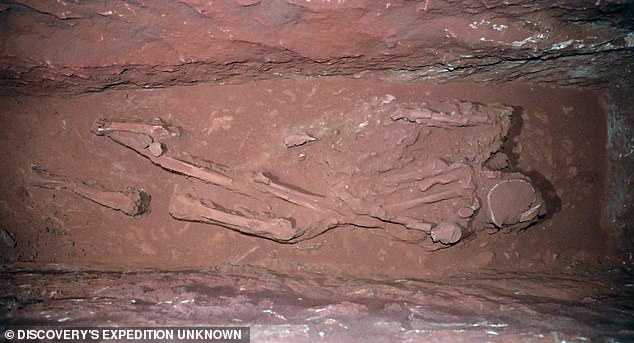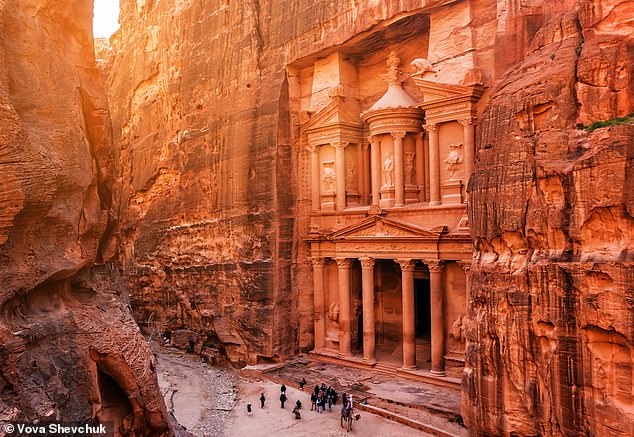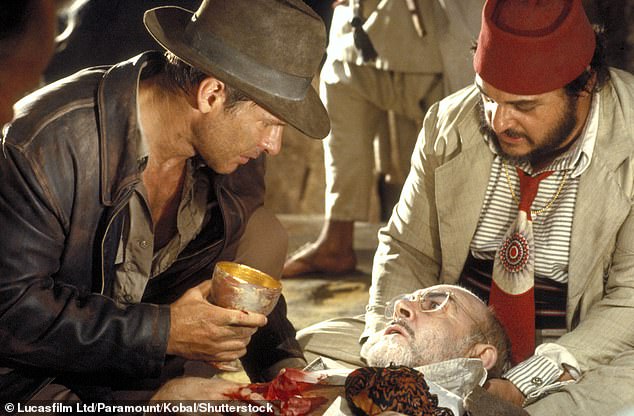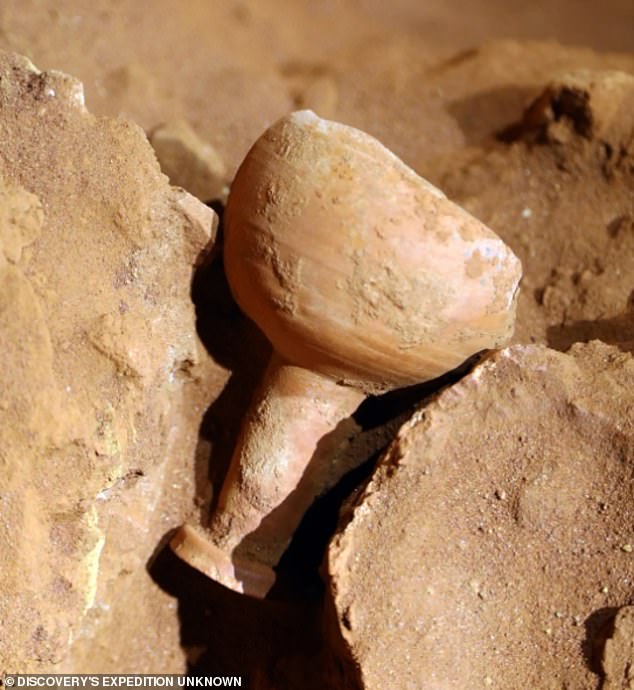In the 1989 film ‘Indiana Jones and the Last Crusade’, the Holy Grail is found hidden deep within the Arab Temple of the Sun.
In an almost bizarre coincidence, archaeologists discovered a “holy grail” cup and 12 bodies inside the film’s real-life filming location in Jordan.
Researchers made this shocking discovery this summer while excavating the 2,000-year-old Al Khazneh, or Treasury, in the ancient city of Petra.
But one expert now says that, despite the striking resemblance to the film’s subject, it is not “art imitating life.”
writing in The conversationArchaeologist Claire Isabella Gilmour, from the University of Bristol, unravels the mystery of the remarkable real-life object.
Instead of a sacred chalice that gives eternal life to the drinker like the one in the film, it was simply a standard glass used by the Nabataeans, the ancient Arab people who built Al Khazneh, he says.
However, archaeologists still have no idea about the identities of the 12 people buried next to him.
Expert solves mystery of real ‘Holy Grail’ (pictured) found inside ‘Indiana Jones and the Last Crusade’ filming location
“One of the most headline-grabbing discoveries has been called a ‘holy grail’ in many reports, suggesting that the vessel is similar to the fictional cup from Indiana Jones and the Last Crusade, also discovered in Khazneh,” says Ms. Gilmour.
“In fact, it is a humble jug, not a cup that offers the drinker eternal life.”
According to Gilmour, Lucasfilm Ltd, the production company behind the Indiana Jones films, studied Nabataean pottery to develop the film’s prop.
Ms Gilmour says: “The similarities between the vessels are not a case of art imitating life, but the result of painstaking research into Nabataean pottery carried out by Deborah Fine, who was director of archives at Lucasfilm Ltd. “
He adds that the real-life ‘grail’ found earlier this year was actually a fairly standard example of Nabataean pottery.
“Nabataean pottery is very thin, often only 1.5mm thick, and is better suited to ceremonial purposes or local use than the thicker and more robust contemporary Roman pottery, which could travel better,” says Ms Gilmour. .
The academic adds that these types of vessels, while not exactly an innovative find, reflect “the status of Petra as an important trading point and the skill of the Nabataeans in creation and invention.”
Archaeologists believe that the ancient city of Petra was inhabited from approximately 7000 BC. C. until approximately 700 AD. c.

The grail was found alongside the bodies of 12 people (pictured) inside a hidden tomb. Archaeologists still have no idea of the identity of the dead
Home to the Nabataean civilization, an ancient nomadic Arab group, Petra was located on a key trade route connecting Egypt, the Mediterranean and the Arabian Peninsula.
This strategic location allowed Petra to flourish throughout the 1st century AD until it became an advanced and cosmopolitan city.
Carved directly into the valley’s pink sandstone, Al Khazneh is one of the city’s most recognizable structures and was built around 40 AD. C. by the Nabataean king Aretas IV Philopatris, probably as a tomb.
During the filming of ‘Indiana Jones and the Last Crusade’, the building’s imposing façade was used to represent the exterior of the Temple of the Sun, while the interior shots were filmed at Elstree Studios in England.
In 2003, expeditions discovered two previously unknown tombs beneath the left side of Al Khazneh, containing partial skeletal remains.
Further studies using ground-penetrating radar (a surveying technique that emits pulses of electromagnetic waves) suggested there could be even more tombs hidden beneath the floors.
When scientists finally dug deeper into the temple in August this year, they were surprised to discover a hidden tomb carved directly into the rock.
Inside were the bodies of 12 unknown people along with funerary items made of ceramic, bronze, iron and pottery.

The grail was found inside Al Khazneh (pictured), a massive structure within the ancient city of Petra, Jordan. This building was used to film the exterior shots of the Temple of the Sun in the third Indiana Jones film.
Filmed as part of the Discovery Channel’s ‘Expedition Unknown’ show, what really caught the researcher’s attention was a simple ceramic pot.
This grail-shaped cup looked remarkably similar to the one used in the film starring Sean Connery and Harrison Ford that had been filmed in that same location.
The documentary’s presenter, Josh Gates, said: “This is perhaps the most important tomb ever found in Petra and a discovery of historic proportions.”
Gates added that the cup “looked almost identical to the holy grail featured in Indiana Jones and the Last Crusade.”
Meanwhile, other scholars have been significantly more critical of Expedition Unknown’s coverage of Petra’s tomb.
In THEY CONTAIN BURIALS! No one is surprised except people who haven’t done their research!
In THEY CONTAIN BURIALS! No one is surprised except people who haven’t done their research!
In THEY CONTAIN BURIALS! No one is surprised except people who haven’t done their research!
However, even if this hidden tomb had not contained the holy grail, it still contains an archaeological mystery.
Since the Nabataeans did not write much about their own culture, there is a lot archaeologists don’t know about how these people lived and died in Petra.

Although it bears a striking resemblance to the grail depicted in the film starring Harrison Ford (left) and Sean Connery (below), experts say the real “grail” is nothing more than a standard, albeit antique, mug.
Mrs Gilmour says: “We still know nothing about the identities of those buried, although their burial in separate sarcophagi and their location in Khazneh suggest high status.”
Importantly, the bodies found at Al Khazneh are articulated, meaning no one has searched through the bones since they were buried.
At a site that has been the subject of hundreds of years of archaeological excavations, vandalism and looting, this is a rather rare find.
It makes the identities of those buried in the Al Khazneh tomb an intriguing enigma and a potential source of vital information.
Ms Gilmour adds: ‘The work of analyzing and interpreting these new findings is just beginning.
‘One of the enduring mysteries is the true purpose of the Khazneh.
“These burials could help answer that question, while revising our understanding of this ancient cosmopolitan city.”


